Growing blue vervain stands as one of the most rewarding experiences for gardeners seeking to cultivate North America’s most striking native wildflowers. They command attention with their towering purple spires that rise like natural candelabras above the garden landscape.
Known scientifically as Verbena hastata and belonging to the vervain family Verbenaceae, this impressive perennial goes by several common names. These include American vervain, swamp verbena, and simpler’s joy.
Native throughout the continental United States and much of southern Canada, blue vervain has graced North American wetlands and prairies for millennia, earning reverence from indigenous peoples who recognized both its beauty and medicinal properties.
Growing blue vervain transforms any garden space with its architectural presence, reaching heights of 3 to 6 feet while spreading slowly to form elegant colonies.
Blue vervain produces its signature purple-blue flower spikes from mid-summer through early fall, creating an extended season of color when many other blooms have faded.
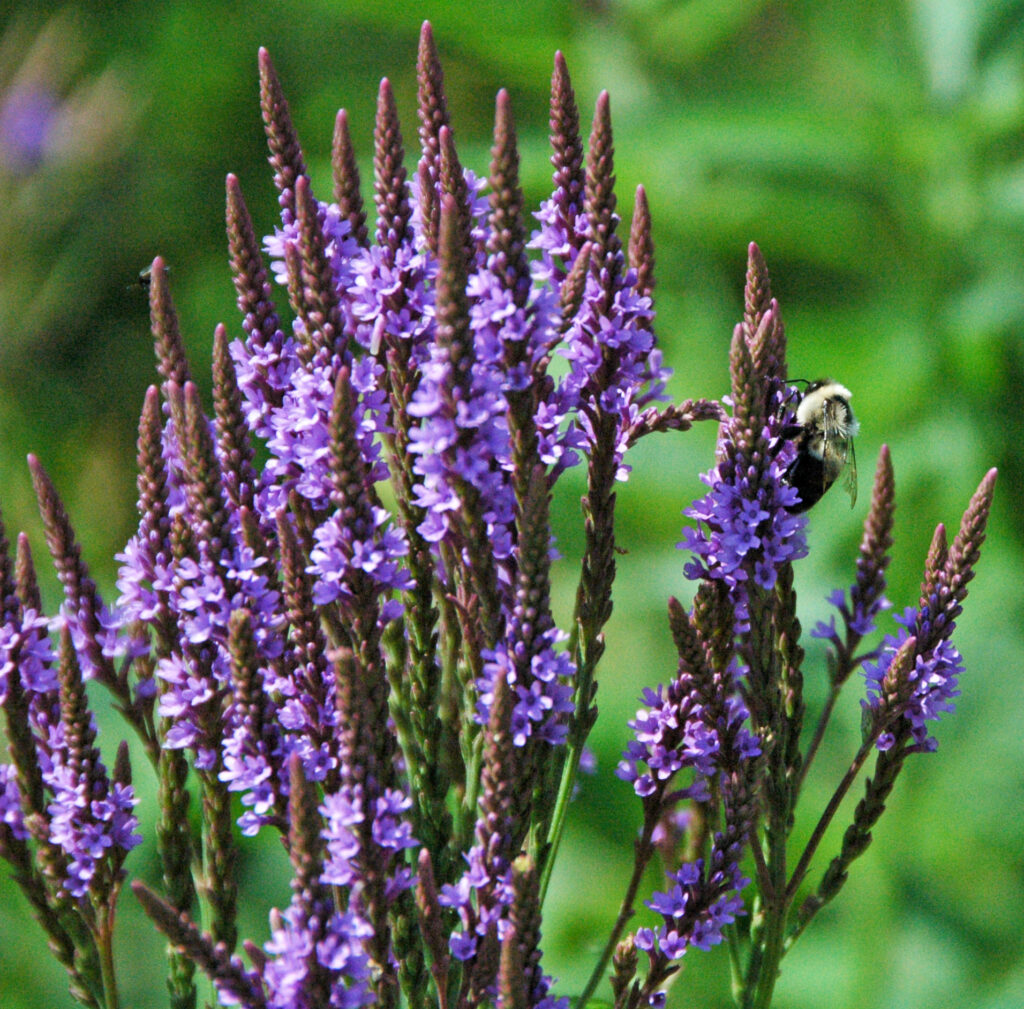
The tiny tubular flowers arrange themselves in distinctive branching spikes that bloom progressively from bottom to top, ensuring weeks of continuous flowering that captivates both gardeners and wildlife alike.
Home gardeners choose growing blue vervain for its outstanding wildlife value and naturalistic beauty. This native wildflower serves as a crucial late-season nectar source when pollinators need it most, attracting specialist bees, bumblebees, and numerous butterfly species. The seeds provide essential food for cardinals, sparrows, and juncos throughout fall and winter months.
In landscape design, growing blue vervain excels as a dramatic vertical accent in rain gardens, pond edges, and naturalized areas. Its tall spires create stunning backdrops in perennial borders. And its tendency to self-seed makes it perfect for establishing sustainable wildflower meadows.
Growing blue vervain provides exceptional ecological benefits by supporting specialized relationships with native insects. It serves as the primary larval host for the verbena moth and common buckeye butterfly, while offering critical habitat for the specialist bee Calliopsis nebraskensis.
These relationships underscore blue vervain’s importance in supporting biodiversity and maintaining healthy native ecosystems across its extensive range.
Blue Vervain Plant Characteristics for Successful Garden Planning
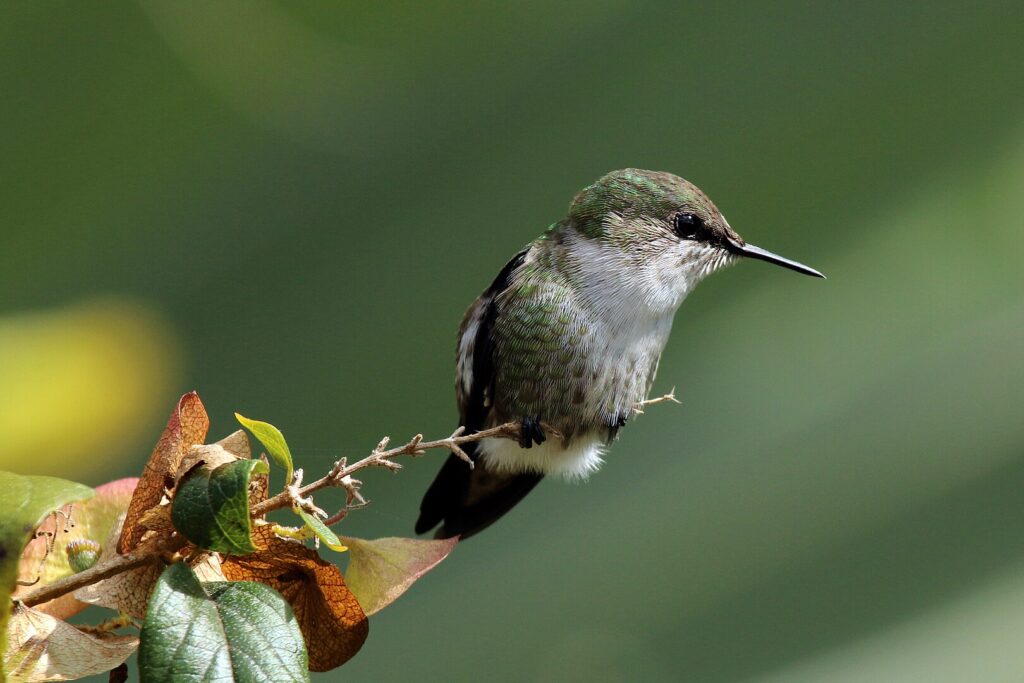
Growing blue vervain successfully begins with understanding this native perennial’s impressive physical characteristics and growth requirements. Blue vervain typically reaches mature heights of 3 to 6 feet tall with a spread of 1 to 3 feet wide.
This makes it an ideal choice for creating dramatic vertical elements in various garden settings.
This stately wildflower performs exceptionally well in rain gardens, pond margins, wet meadows, native plant gardens, pollinator gardens, and naturalized landscape areas where its architectural form can be fully appreciated.
The robust growth habit and adaptable nature of blue vervain make it particularly valuable for gardeners developing sustainable landscapes that support both ornamental beauty and ecological function.
Common garden applications include using blue vervain as backdrop plantings in perennial borders, accent specimens in prairie-style gardens, and foundation elements in bioretention areas designed to manage stormwater runoff.
Key characteristics that define successful blue vervain cultivation include:
- Lifespan: Short-lived perennial (2-3 years, but self-seeds)
- Mature height: 3-6 feet tall
- Mature spread: 1-3 feet wide, slowly expanding through rhizomes
- Growth habit: Upright, clump-forming with stiff branching stems
- Bloom color: Purple-blue to violet-purples
- Bloom size: Individual flowers are small and arranged in 5-13 inch spikes
- Bloom period: Mid-summer through early fall
- Seed germination: 7-14 days (after cold stratification)
- Days to maturity: 80-120 days from germination to first bloom
- Hardiness zones: 3-9
When to Start Growing Blue Vervain from Seed
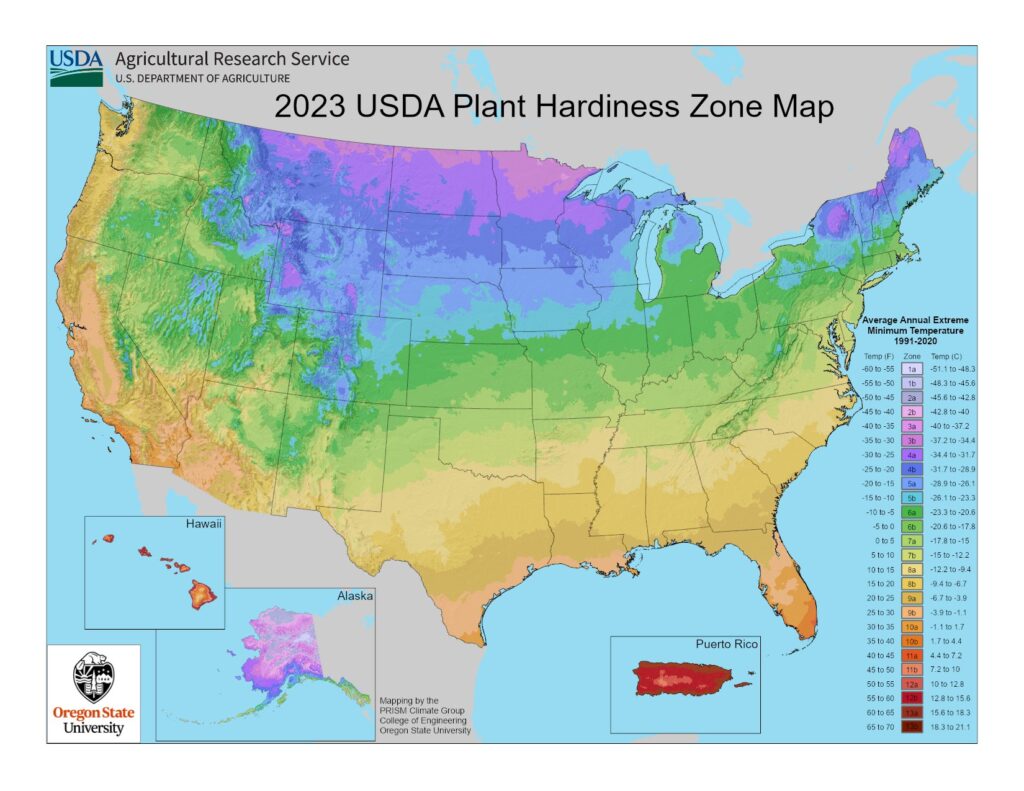
Growing blue vervain from seed requires careful timing based on your hardiness zone. Blue vervain seeds benefit from cold stratification and respond best to cool weather sowing. This makes fall and early spring the preferred planting windows across most regions.
Zones 3-5
Start blue vervain seeds indoors 8-10 weeks before the last expected frost date, typically mid-February to early March.
Direct sow seeds outdoors in late fall (October-November) or very early spring (March-April) when soil can be worked but temperatures remain cool.
Zones 6-8
Start blue vervain seeds indoors 6-8 weeks before the last expected frost date, typically late February to mid-March.
Direct sow seeds outdoors in late fall (November-December) or early spring (February-March) when soil temperatures are consistently cool.
Zones 9-12
Start blue vervain seeds indoors during late winter months (January-February) for spring transplanting.
Direct sow seeds outdoors during the coolest months available, typically December through February.
However, blue vervain requires cool conditions for optimal germination and may struggle with extreme heat during establishment. You may need to cold stratify the seeds before direct sowing if temperatures don’t dip long enough in Zones 9-12.
Blue Vervain Seed Preparation for Optimal Germination
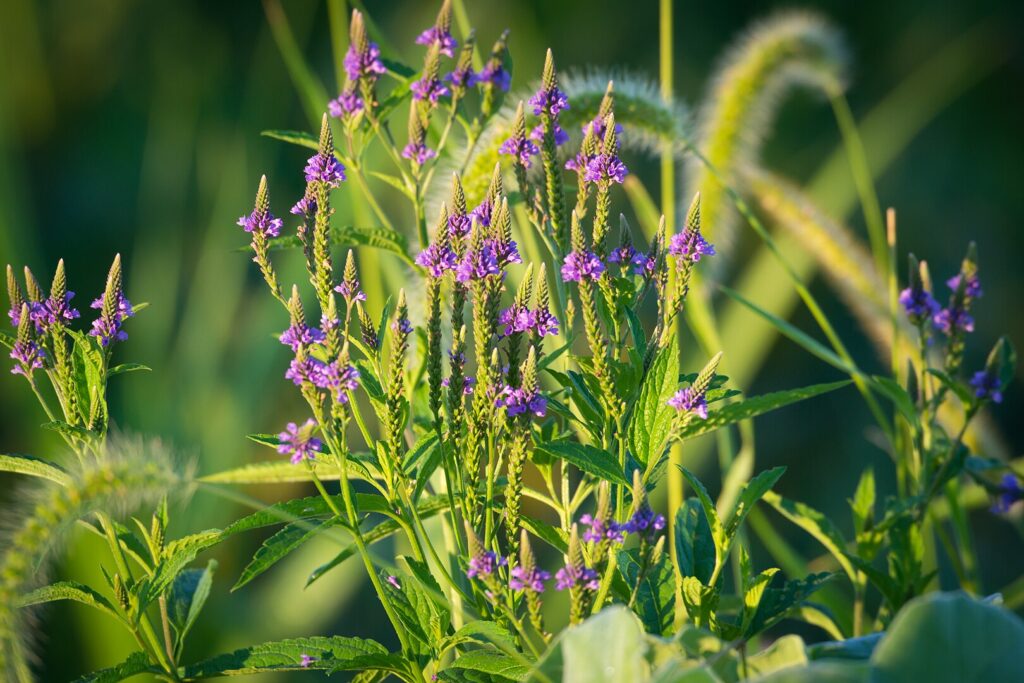
Growing blue vervain from seed requires specific preparation techniques to break the natural dormancy mechanisms that ensure survival in wild conditions.
Blue vervain seeds typically germinate within 7-14 days after proper preparation, but without cold stratification, germination rates remain poor and erratic.
This cold treatment mimics the natural winter conditions that break seed dormancy in wild populations.
To cold stratify blue vervain seeds, mix them with slightly damp clean sand, vermiculite, or peat moss in a sealed plastic bag or container. Store this mixture in the refrigerator at temperatures between 35-40 degrees Fahrenheit for exactly 30 days.
Check the mixture weekly to ensure it remains lightly moist but not waterlogged, and watch for any early germination during the stratification period.
Additional techniques for improving blue vervain seed germination include ensuring seeds receive adequate light during the germination process. Blue vervain exhibits light-dependent germination.
Surface sow stratified seeds or cover them only very lightly with growing medium. Maintain consistent soil temperatures between 60-70 degrees Fahrenheit after the stratification period ends.
Preparing Your Garden Environment for Growing Blue Vervain
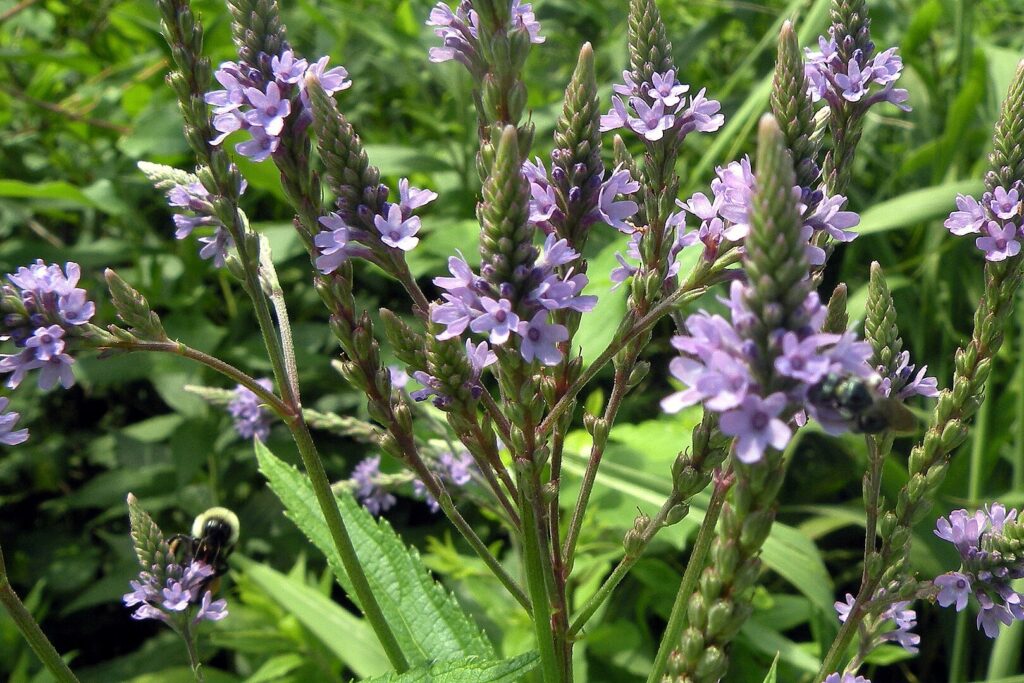
Preparing an appropriate garden bed is crucial for successfully growing blue vervain, as this native wildflower thrives when its natural habitat preferences are replicated in cultivation.
Blue vervain naturally occurs in wet meadows, stream banks, and marsh edges, making soil preparation and site selection particularly important for establishing healthy, long-lived colonies that will self-sustain and support wildlife for years to come.
Choosing a Location
Select a garden location that can accommodate blue vervain’s impressive mature size and spreading habit. Growing blue vervain works best in areas where the tall spires can serve as backdrop plantings or vertical accents without overwhelming smaller plants.
Ideal locations include rain garden depressions, pond margins, the back of perennial borders, or naturalized areas.
Avoid planting blue vervain in formal garden settings where its informal spreading habit might conflict with structured design elements.
Light Requirements
Blue vervain performs optimally in full sun conditions that receive 6 or more hours of direct sunlight daily. It will tolerate partial shade with 4 to 6 hours of sun.
Full sun exposure promotes the most robust flowering and strongest stem development. Partial shade locations may result in slightly taller but less sturdy plants that require staking.
Growing blue vervain in deep shade significantly reduces flowering and overall plant vigor.
Moisture
Consistent soil moisture is essential for successfully growing blue vervain, as this species naturally thrives in wetland environments. The planting site should retain moisture well or have access to supplemental irrigation during dry periods.
Blue vervain tolerates temporary flooding and standing water better than drought conditions, making it excellent for areas with drainage challenges.
However, the plant adapts to average garden moisture levels when provided with regular watering during establishment and dry spells.
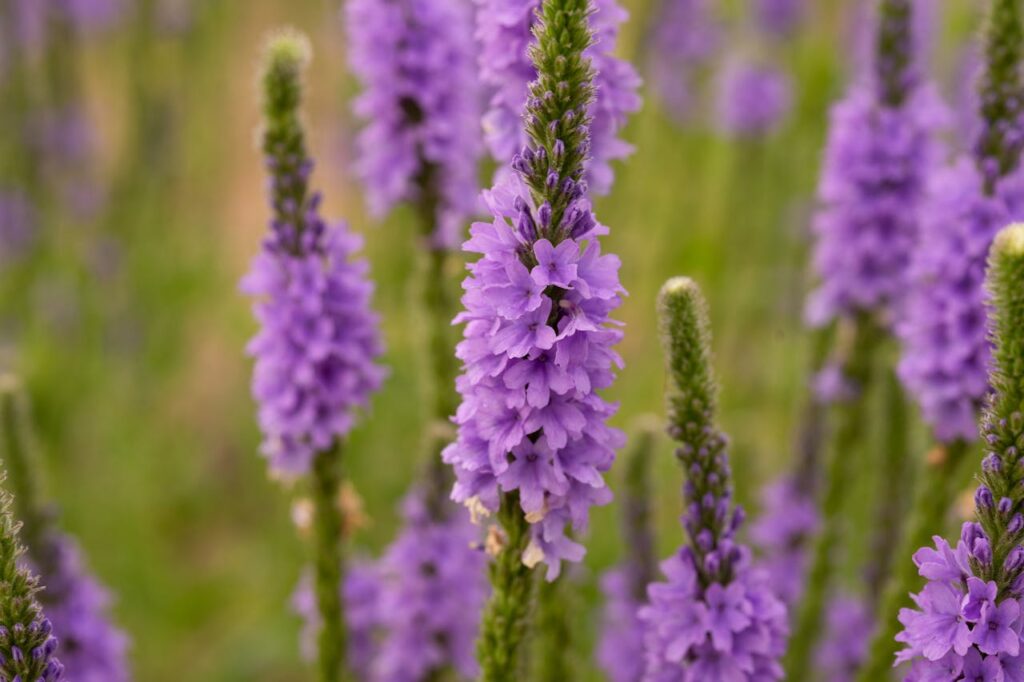
Soil Type Preferred
Blue vervain grows best in fertile, loamy soils with high organic matter content, though it adapts to clay, sand, and mucky conditions found in its native wetland habitats.
The ideal soil pH ranges from 6.0 to 7.5, with slightly acidic to neutral conditions producing the strongest growth.
Heavy clay soils are well-tolerated provided they retain moisture, while sandy soils require additional organic matter to maintain adequate moisture retention for optimal blue vervain cultivation.
Preparing the Soil
Begin soil preparation by removing all weeds and grass from the planting area, as blue vervain seedlings cannot compete effectively with established vegetation. Work compost or well-aged manure into the top 6-8 inches of soil at a rate of 2-3 inches of organic matter per square yard.
In sandy soils, increase organic matter to 4 inches per square yard to improve moisture retention. Test soil pH and adjust if necessary using lime to raise pH or sulfur to lower it toward the optimal 6.0-7.5 range.
Create gentle depressions or berms if needed to improve water retention in the blue vervain planting area.
Need for Support
Growing blue vervain typically does not require much support. However, plants grown in partial shade or very rich soils may benefit from discrete staking to prevent lodging during heavy rains or storms.
Direct Sowing Blue Vervain Seeds
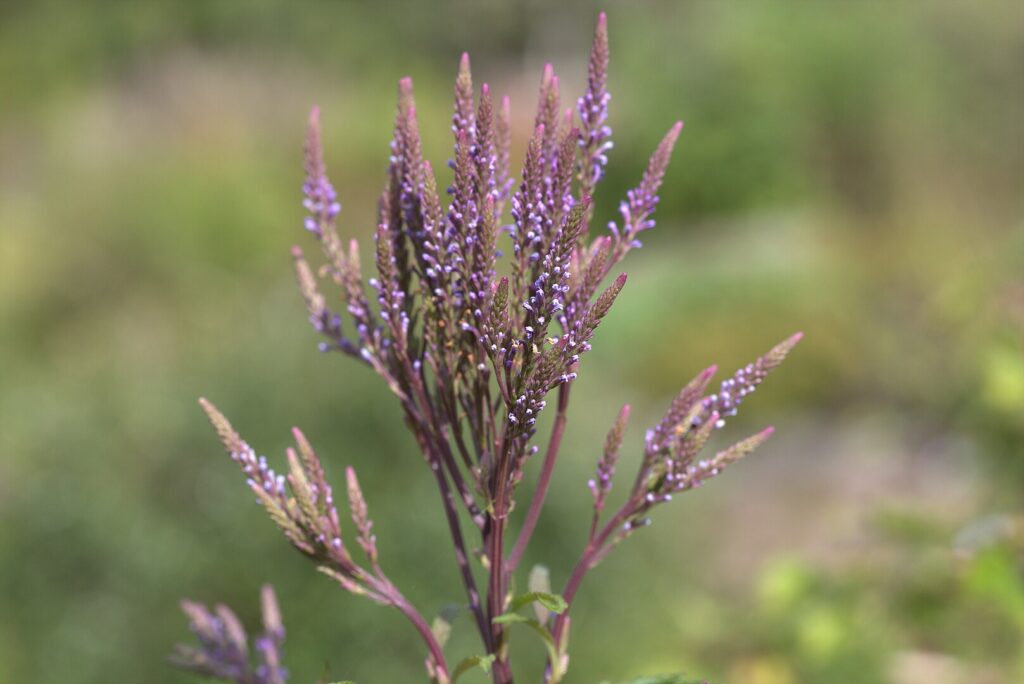
Growing blue vervain through direct sowing offers the most natural approach to establishing this native wildflower. This allows the seeds to experience the winter stratification process that occurs in wild populations.
This method works particularly well for large naturalized areas, rain gardens, and wildlife habitats where blue vervain can establish self-sustaining populations.
- Surface sow blue vervain seeds or cover with only 1/8 inch of soil.
- Scatter seeds on prepared soil and lightly rake to ensure good seed-to-soil contact.
- Keep soil consistently damp like a wrung-out sponge throughout germination.
- Water with fine mist to avoid disturbing small seeds.
- Blue vervain seeds germinate when soil temperatures reach 60-70°F after cold stratification.
Fall-sown seeds naturally stratify over winter and germinate in spring. Spring sowings require 30 days of refrigerator stratification before planting.
Properly stratified blue vervain seeds germinate within 7-14 days under optimal conditions.
Fall-sown seeds appear 2-3 weeks after the last frost date, while spring-sown seeds germinate within two weeks of planting when conditions are favorable.
Starting Blue Vervain Seeds Indoors
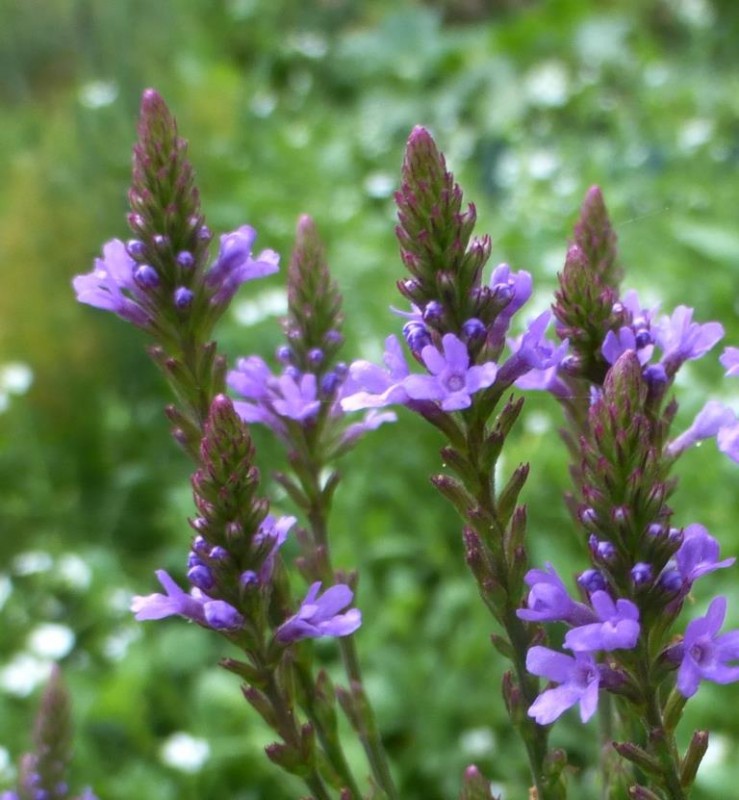
Growing blue vervain from seed indoors provides better control over germination and allows for earlier transplants.
Indoor seed starting works well for gardeners in shorter seasons or those wanting precise garden placement where direct sowing is challenging.
Choosing Seed Starting Mix
Use well-draining, sterile seed starting mix that retains moisture without becoming waterlogged. Mix equal parts peat moss or coconut coir, vermiculite, and perlite.
Choosing Containers for Starting Seeds
Select containers with drainage holes and 2-3 inches of depth. Cell trays with 1-2 inch wide cells or 2-inch soil blocks work best for growing blue vervain.
Depth to Plant
Surface sow blue vervain seeds on moist mix. Cover lightly with vermiculite or fine mix no deeper than 1/16 inch.
Seeds need light to germinate and will fail if buried too deeply. Press gently for good soil contact without burying completely.
Moisture Requirements for Seeds
Keep mix consistently moist but not waterlogged. Mist daily or use bottom watering. Cover trays with clear plastic to maintain humidity. Remove covers when seedlings emerge to prevent fungal problems.
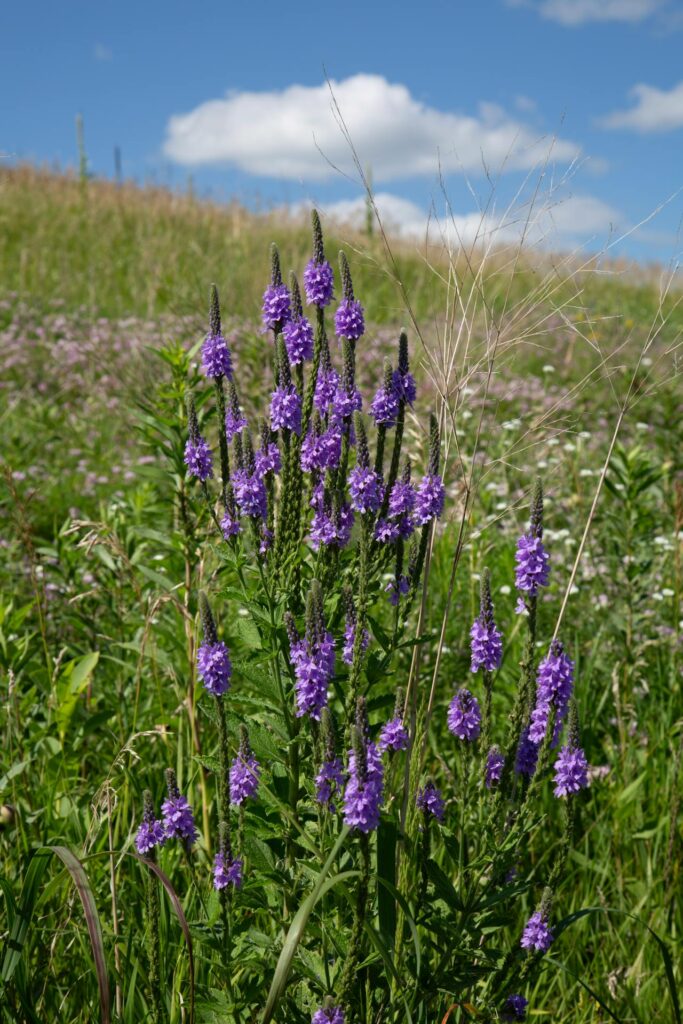
Optimal Temperature for Germination
After stratification, maintain 60-70°F soil temperature in sowing. Use heating mats if needed. Monitor soil temperature rather than air temperature for growing blue vervain successfully.
Light Requirements for Germination
Provide bright light immediately after sowing. Place under grow lights 2-3 inches above containers or in a bright south window. Maintain 12-16 hours of light daily during germination and seedling development.
Time to Germination
Blue vervain seeds germinate within 7-14 days under optimal conditions after proper stratification. Germination may be uneven over 2-3 weeks. Maintain consistent moisture and light until all viable seeds emerge.
When to Transplant Blue Vervain Seedlings
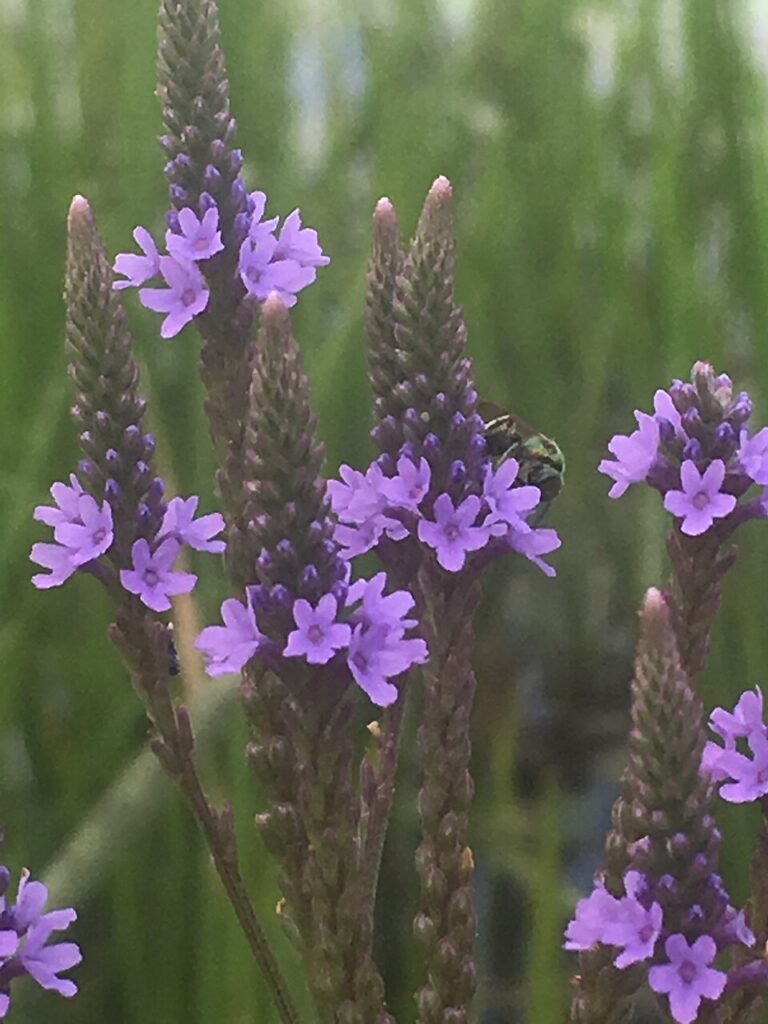
Growing blue vervain seedlings requires careful timing to ensure successful transplantation from indoor conditions to the garden environment.
Blue vervain seedlings are ready for transplanting when they develop their second set of true leaves and reach 2-3 inches in height with sturdy stems.
The root system should be well-developed enough to hold the soil block or cell together when removed from containers.
Seedlings should appear vigorous with good green color and no signs of stress or disease before attempting transplantation.
Wait until all danger of frost has passed and soil temperatures consistently remain above 50°F before transplanting blue vervain outdoors.
Hardening Off Blue Vervain Plants
Hardening off prepares indoor-grown blue vervain seedlings for outdoor conditions by gradually exposing them to temperature fluctuations, wind, and direct sunlight over a 7-10 day period.
- Day 1-2: Place seedlings outdoors in shade for 2-3 hours during warmest part of day, bring indoors each evening
- Day 3-4: Increase outdoor time to 4-5 hours with partial sun exposure
- Day 5-6: Leave plants outside 6-8 hours with partial to full sun conditions
- Day 7-8: Keep seedlings outdoors all day in full sun conditions
- Day 9-10: Leave hardened plants outside overnight if temperatures stay above 45 degrees Fahrenheit
- Monitor for stress signs like wilting or leaf scorch and reduce exposure if needed
- Water more frequently during hardening as outdoor conditions increase water needs
- Extend hardening period if weather conditions are harsh or unstable
Transplanting Blue Vervain Seedlings into the Garden
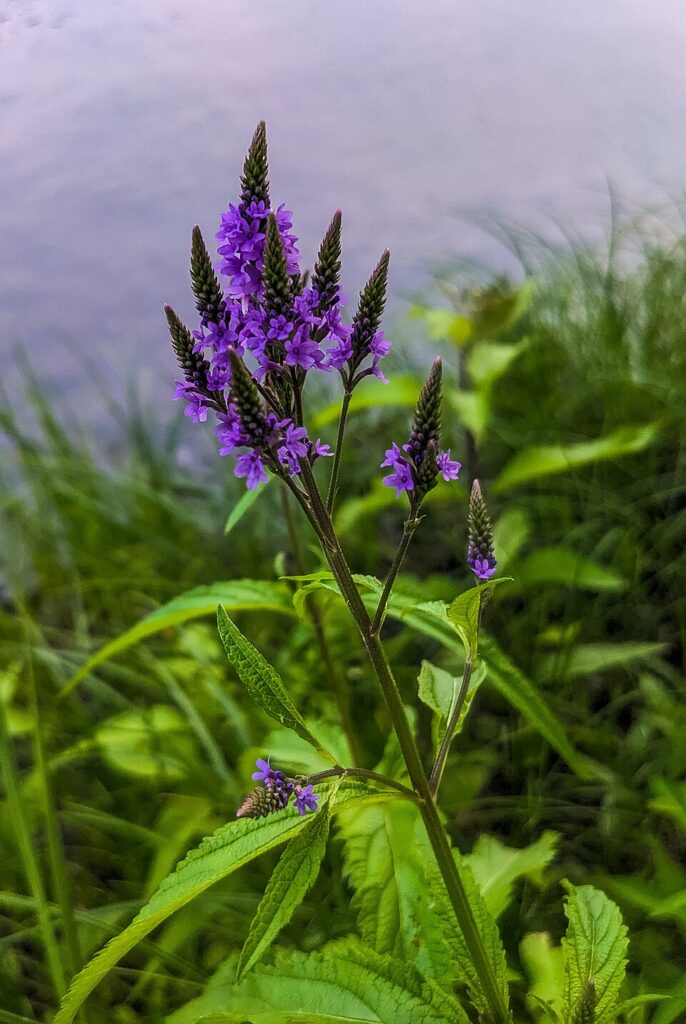
Growing blue vervain successfully requires proper planting technique to ensure strong establishment and healthy development in the garden environment. Plant during mild weather with adequate soil moisture and stable temperatures forecasted.
- Plant at same depth as containers with soil line matching previous growing level
- Space plants 12-24 inches apart in gardens, 18-36 inches apart in naturalized areas
- Apply 2-3 inches of organic mulch, keeping 2-3 inches away from plant stems
- Water thoroughly after planting, provide 1-2 inches weekly for first month, then reduce frequency as plants establish
Ongoing Care for Established Blue Vervain Plants
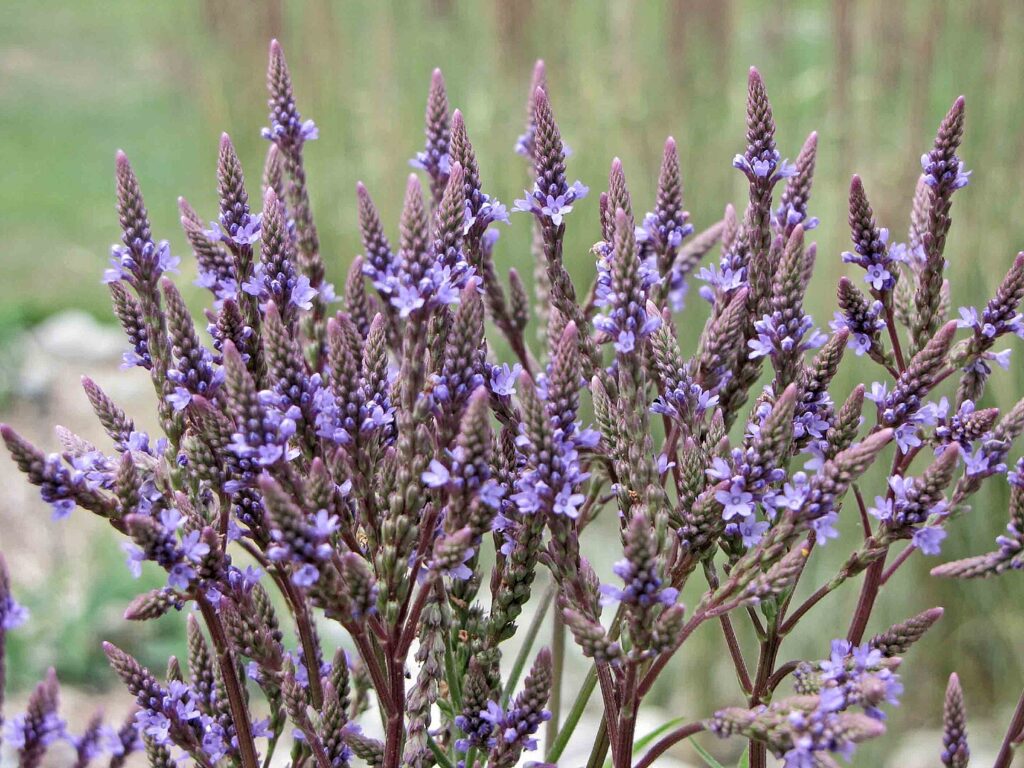
Growing blue vervain requires minimal maintenance once plants establish, making this native wildflower an excellent choice for low-maintenance gardens and naturalized landscapes.
Blue vervain’s hardy nature and adaptation to diverse conditions mean most care focuses on supporting the plant’s natural growth habits rather than intensive management.
Watering
Established blue vervain tolerates drought conditions but performs best with consistent moisture during the growing season.
Water deeply once weekly during dry periods, providing 1 inch of water including rainfall. Plants in clay or moisture-retentive soils need less supplemental watering than those in sandy conditions.
Reduce watering frequency in fall as plants prepare for dormancy.
Feeding
Blue vervain requires minimal fertilization and often performs better in average to poor soils than in overly rich conditions. Avoid nitrogen-heavy fertilizers that promote excessive foliage growth at expense of flowering.
Apply 1-2 inches of compost around plants in early spring if soil quality is poor. Growing blue vervain in naturally fertile soils typically requires no additional feeding.
Weeding
Keep the area around blue vervain free of competing weeds during the first growing season until plants establish strong root systems.
Hand-pull weeds carefully to avoid disturbing shallow feeder roots. Or crop weeds close to the soil and use as a mulch around your vervain plants.
A 2-3 inch mulch layer will help to suppress weed growth naturally. Once established, blue vervain competes well with most weeds and may self-seed to fill gaps.
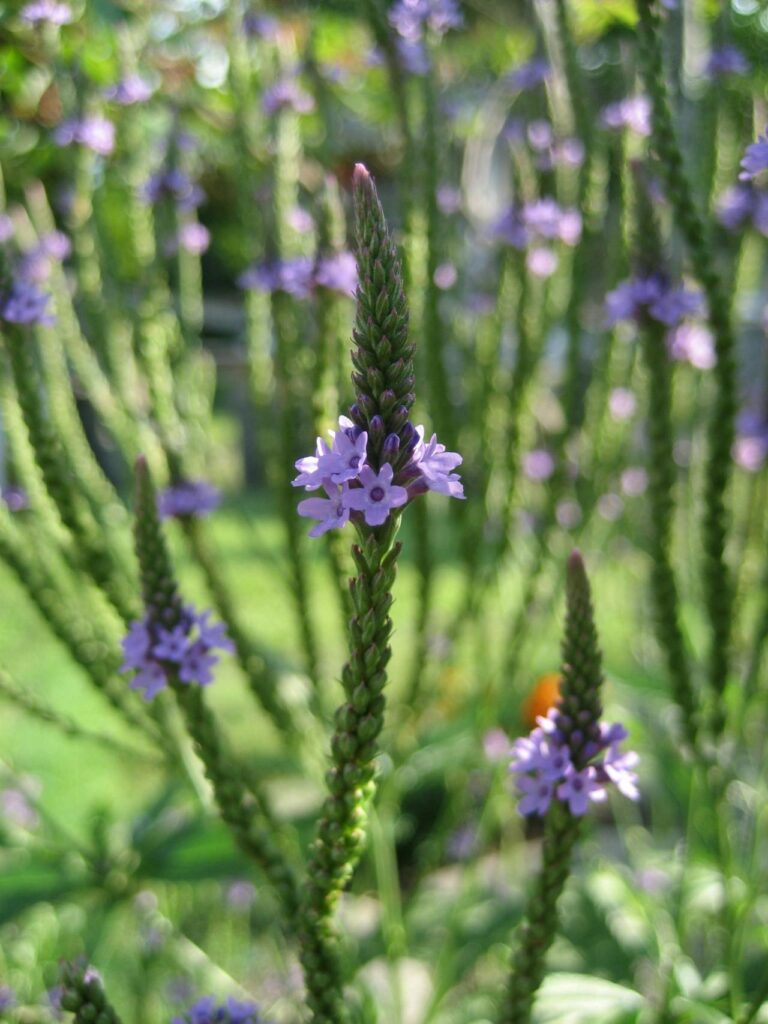
Pest Control
Blue vervain experiences few serious pest problems due to its native status and natural resistance.
Monitor for aphids during peak growing season and treat with insecticidal soap if populations become excessive.
Rabbits may browse young foliage but rarely cause significant damage. Most mammals avoid blue vervain due to its bitter taste, making pest control largely unnecessary for successful blue vervain cultivation.
Tips and Tricks for Growing Blue Vervain
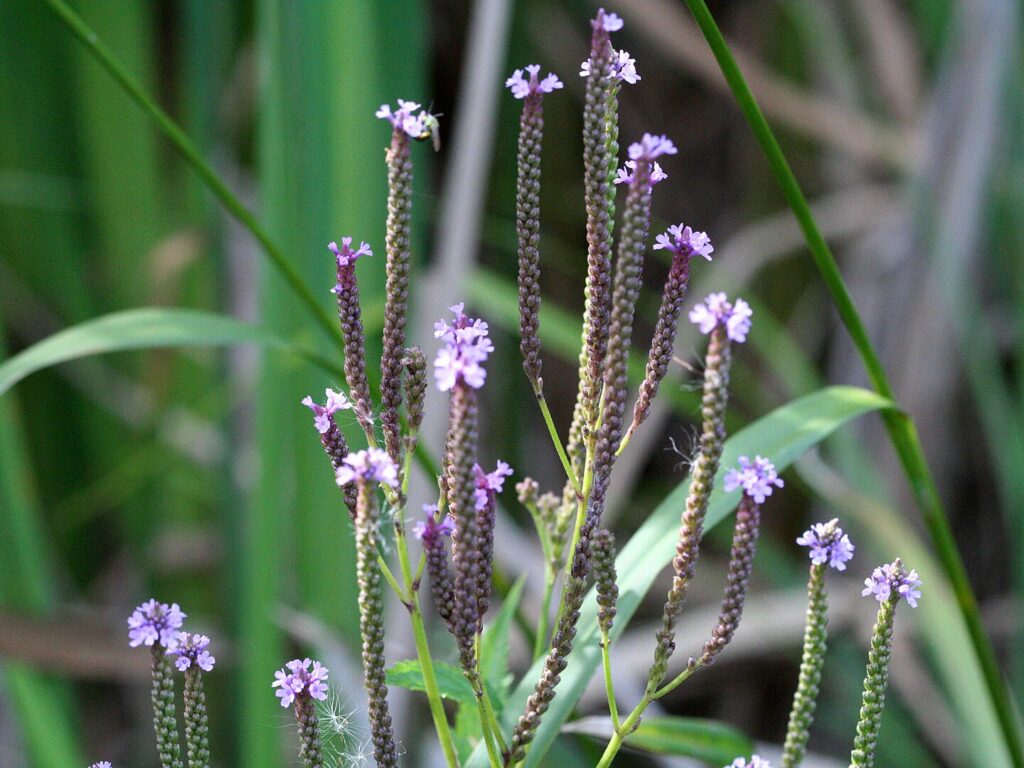
Growing blue vervain benefits from several specialized techniques that enhance flowering, encourage natural spreading, and maximize wildlife value in the garden setting.
Pinching: Pinch growing tips when plants reach 12-18 inches tall to encourage bushier growth and more flower spikes
Staking: Plants grown in partial shade or very fertile soil may require discrete staking with bamboo poles placed behind clumps
Deadheading Strategy: Leave some spent flower heads for seed production and bird feeding while removing others to extend the blooming period
Self-Seeding Management: Allow plants to self-seed in desired areas by leaving soil bare around parent plants in late fall
Companion Planting: Pair with other native wetland plants like joe-pye weed and boneset for extended pollinator support
Cutting for Arrangements: Harvest flower spikes when bottom flowers just begin opening for the longest vase life
Division Timing: Divide established clumps every 3-4 years in early spring before new growth begins
Winter Interest: Leave dried flower stalks standing through winter to provide seeds for birds and structural garden interest
Succession Planting: Sow additional seeds every 2-3 years to maintain continuous populations as individual plants are short-lived
Wildlife Enhancement: Plant in groups of 5 or more for maximum impact on specialist pollinators and seed-eating birds
Blue Vervain As Cut Flowers
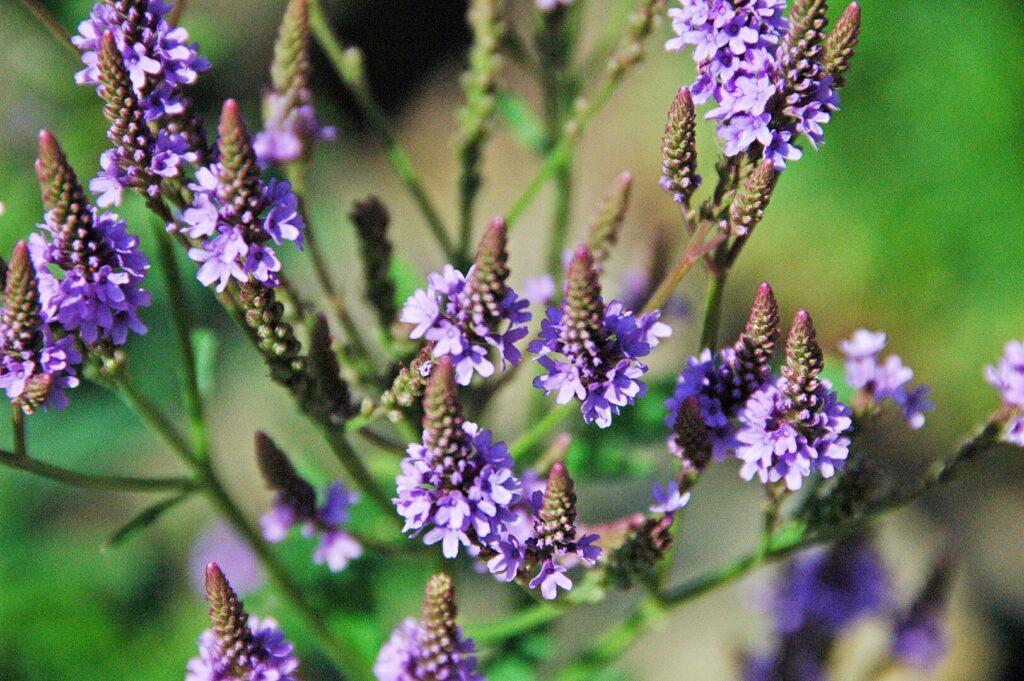
Growing blue vervain provides excellent opportunities for cut flower arrangements. The distinctive purple spikes add dramatic vertical elements to both fresh and dried bouquets.
Harvest blue vervain stems when the bottom third of flowers on each spike have opened but before the entire spike reaches full bloom, typically in mid to late summer.
Cut stems early in the morning when plants are fully hydrated, selecting the straightest, most robust spikes for the longest vase life.
The architectural form of blue vervain makes it particularly valuable in naturalistic arrangements paired with other native wildflowers like goldenrod and asters.
Collecting Seeds from Blue Vervain
Seed collection from blue vervain should occur in late fall when flower spikes have dried completely and seeds rattle easily within the dried calyces.
Cut entire seed heads on a dry, sunny day and place them in paper bags to complete drying indoors.
Once fully dry, shake or rub the seed heads to release the small seeds, then store them in labeled envelopes in a cool, dry location until spring stratification begins.
Growing blue vervain from collected seeds maintains local genetic adaptations and provides abundant propagation material for expanding plantings.
Extended Care and Seasonal Management for Blue Vervain
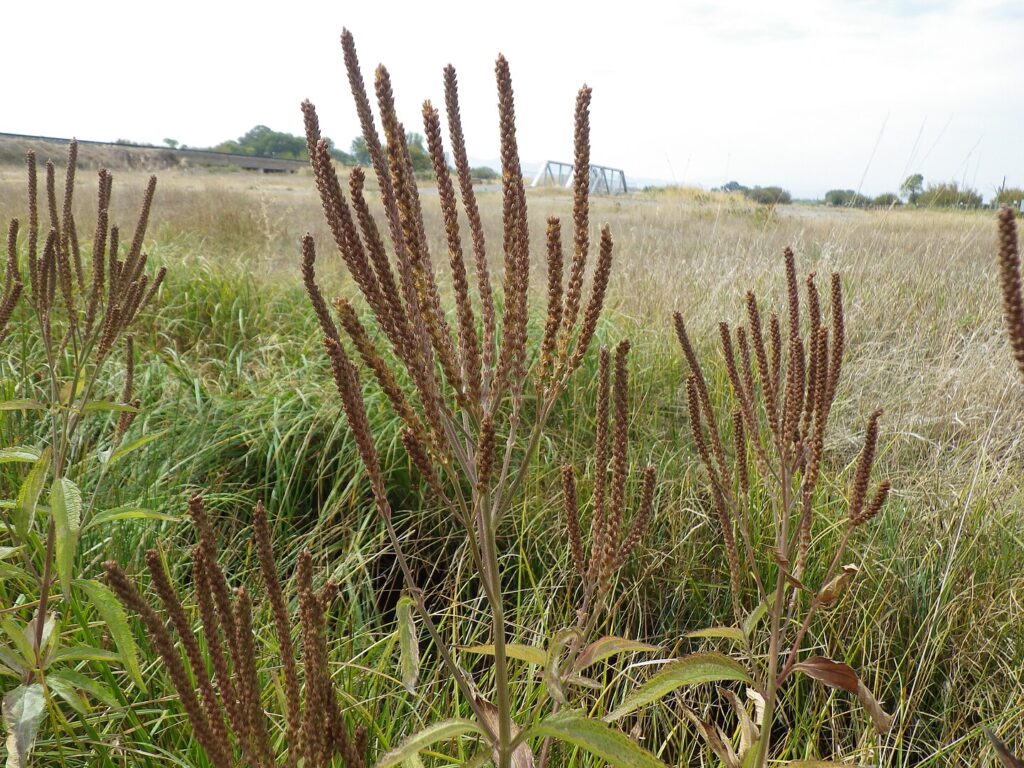
During the winter months, blue vervain enters complete dormancy as above-ground growth dies back to ground level. The root system remains alive beneath the soil surface.
The dried flower stalks provide valuable winter interest in the landscape and serve as important seed sources for birds throughout the cold months.
Prepare blue vervain for winter by ceasing all fertilization by late summer and reducing watering frequency in fall to encourage natural dormancy.
Leave the dried stems and seed heads standing rather than cutting them back, as they protect the crown from extreme cold and provide wildlife habitat.
Spring care for blue vervain involves cutting back the previous year’s dried growth to ground level once new shoots begin emerging from the base, typically in late spring when soil temperatures warm consistently.
Apply a thin layer of compost around the emerging shoots if soil quality is poor, and resume regular watering schedules as active growth begins.
Growing blue vervain successfully over multiple years requires patience during the spring emergence period. These plants may appear later than many other perennials, but will develop rapidly once growing conditions become favorable.
Transform Your Garden into a Native Wildlife Haven with Blue Vervain
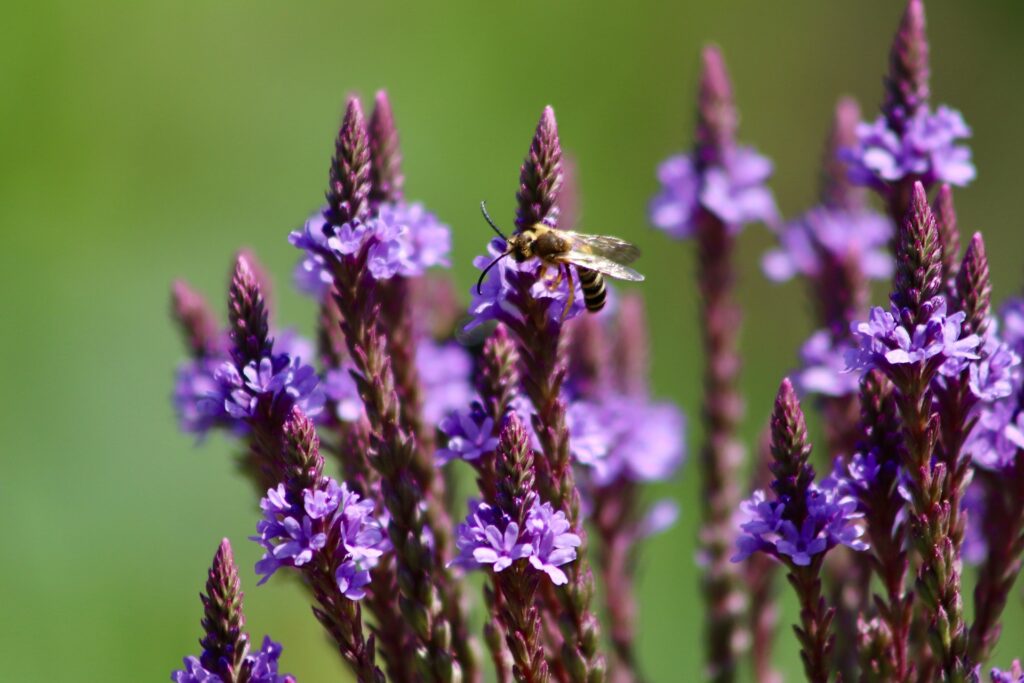
Growing blue vervain rewards gardeners with years of stunning purple spires that attract essential pollinators while supporting local ecosystems through native plant cultivation.
This remarkable wildflower combines architectural beauty with ecological function, creating dramatic vertical accents that serve as magnets for specialist bees, butterflies, and seed-eating birds throughout multiple seasons.
Whether planted in rain gardens, naturalized areas, or perennial borders, blue vervain adapts to various growing conditions. The plant’s ability to self-seed ensures sustainable populations that will grace your landscape for generations while requiring minimal intervention from busy gardeners.
Beyond its ornamental appeal, growing blue vervain contributes to critical habitat restoration and biodiversity conservation in an era when native pollinators face increasing challenges.
Each blue vervain plant supports specialized relationships with native insects while providing essential late-season nectar when other flowers have faded. The seeds sustain cardinals, sparrows, and juncos through the winter months, creating a complete ecosystem support system in your backyard.
Featured Image: By James St. John – Verbena hastata (blue vervain) 4, CC BY 2.0, Link
